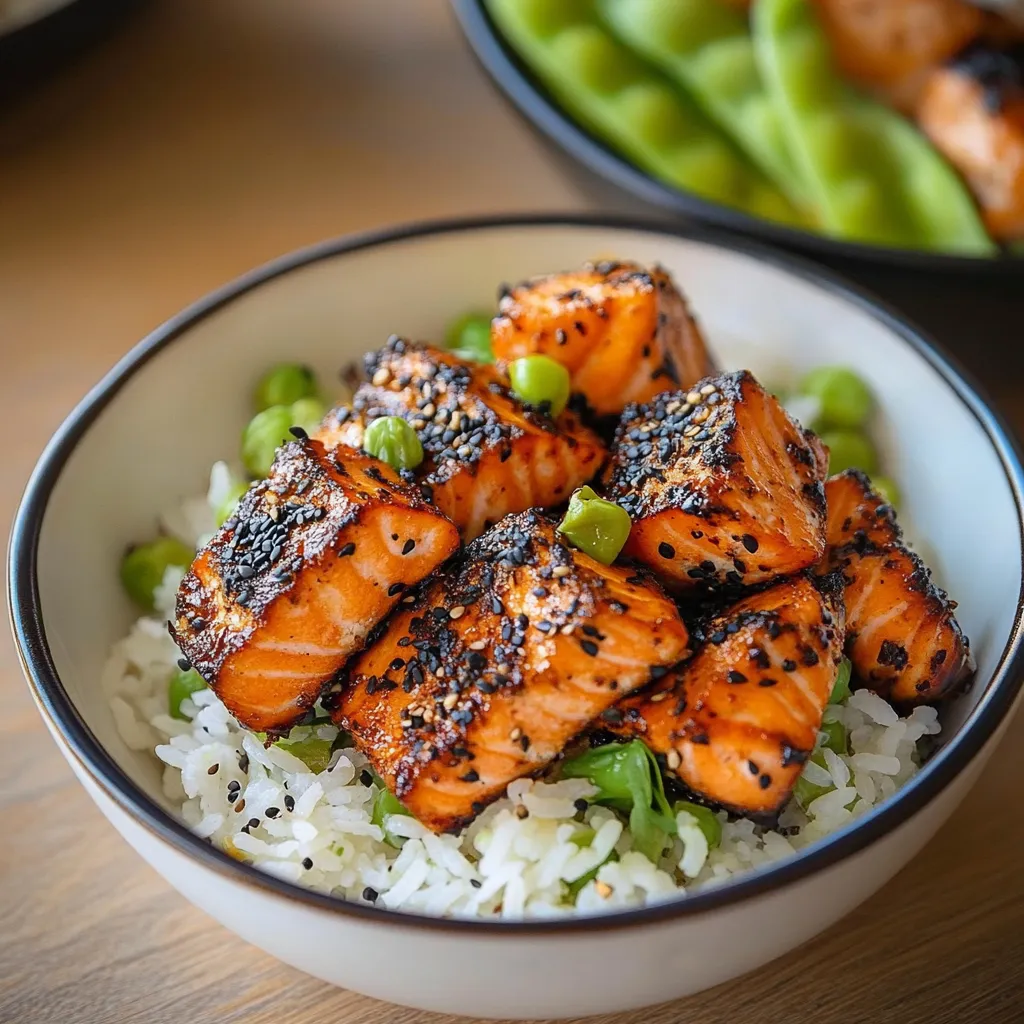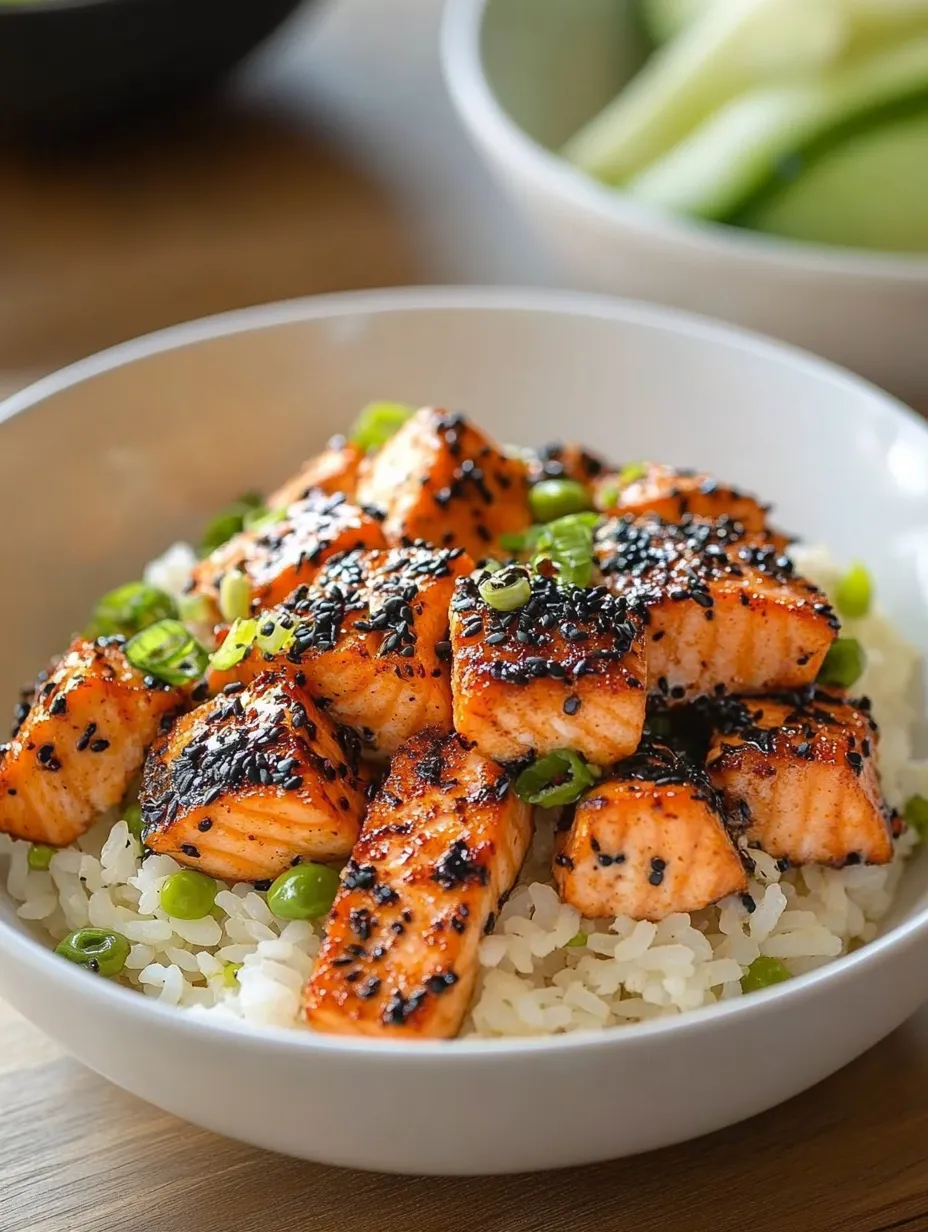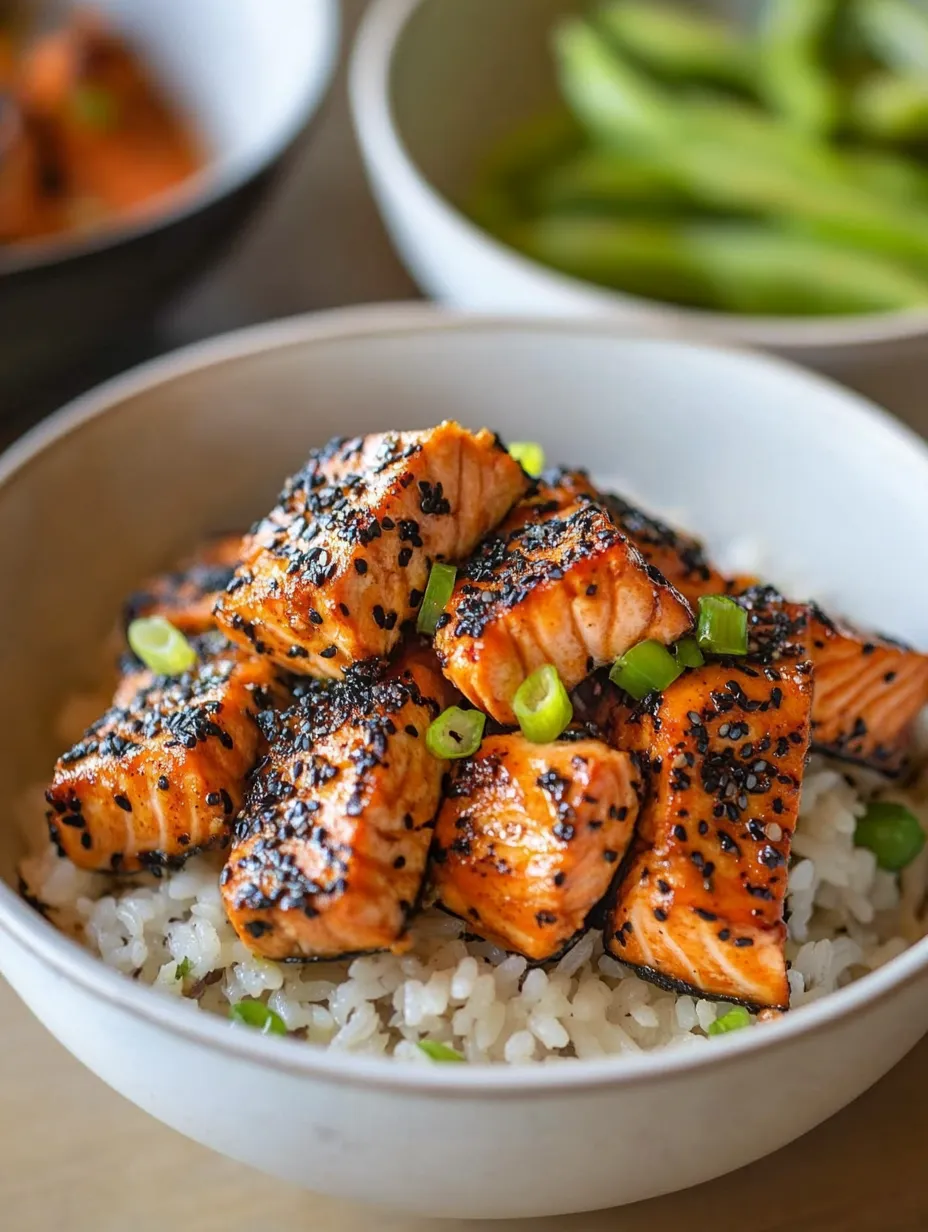 Save
Save
This spicy salmon rice bowl transforms ordinary weeknight dinners into something extraordinary with minimal effort. The combination of crispy sesame-crusted salmon bites atop fluffy rice, all drizzled with a sweet and spicy gochujang sauce creates a flavor explosion that satisfies even the most discerning palates.
I first made this dish after discovering gochujang paste at my local Asian market and have been obsessed ever since. The combination of spicy, sweet and savory elements creates the perfect balance that my family requests at least once every week.
Ingredients
- Salmon cubes the star protein that cooks quickly and absorbs flavors beautifully
- Gochujang paste Korean fermented chili paste that provides complex heat and umami
- Maple syrup natural sweetness that balances the spice perfectly choose pure maple for best results
- Sesame seeds both black and white varieties create a beautiful crust with nutty flavor
- Avocado oil high smoke point oil ideal for achieving that perfect sear without burning
- Kewpie mayo Japanese mayo that adds creaminess and richness to the sauce
- Rice vinegar bright acidity that cuts through the richness look for unseasoned varieties
Step-by-Step Instructions
- Prep the Salmon
- Cut fresh salmon into uniform 1-inch cubes ensuring they will cook evenly. Pat dry with paper towels to help the marinade adhere better and achieve a better sear.
- Make the Marinade
- Whisk together the gochujang paste, maple syrup, and avocado oil until completely smooth. This sweet-spicy mixture will both flavor the salmon and help the sesame seeds stick.
- Create the Sesame Crust
- Combine both sesame seed varieties on a plate. Dip each salmon cube fully in the gochujang marinade, allowing excess to drip off, then roll in the sesame mixture, pressing gently to ensure complete coverage on all sides.
- Fry to Perfection
- Heat avocado oil in a skillet until shimmering but not smoking. Place sesame-crusted salmon cubes with space between each piece and cook until golden and crispy on all sides, about 4 minutes per side. The interior should remain tender and slightly pink.
- Craft the Sauce
- While salmon cooks, whisk together gochujang paste, maple syrup, Kewpie mayo, and rice vinegar until silky smooth. Adjust thickness with a splash of water if needed for the perfect drizzling consistency.
- Assemble Your Bowl
- Layer fluffy rice as the base, arrange the crispy salmon cubes on top, then generously drizzle with the gochujang sauce. The heat from the rice and salmon will slightly warm the sauce, enhancing its flavors.
 Save
Save
The sesame seed crust is absolutely transformative in this recipe. I discovered this technique while traveling through Korea, where a street food vendor created something similar. The way the seeds toast during cooking adds an incredible nutty dimension that elevates the entire dish.
Vegetable Pairings
Fresh vegetables bring color, texture and nutrition to this salmon rice bowl. Cucumber salad with rice vinegar provides cooling crunch against the spicy salmon. Quickly blanched broccoli or steamed edamame add vibrant green color and additional nutrients. For a complete meal, consider adding sliced avocado which brings creaminess that complements the spicy elements beautifully.
Make-Ahead Tips
While this dish shines when freshly made, you can prepare components ahead to streamline dinner service. The gochujang sauce can be mixed and refrigerated up to three days in advance. Rice can be cooked and kept warm in a rice cooker. Even the salmon can be cubed and stored separately from the marinade for up to 24 hours before cooking. Assembly takes just minutes when components are ready.
Ingredient Substitutions
No gochujang available? Substitute with sriracha mixed with a touch of miso paste for complexity. Salmon can be replaced with firm white fish like cod or even cubed chicken thighs for a different protein option. Maple syrup can be swapped for honey or brown sugar dissolved in a bit of water. For a gluten free option, ensure your gochujang paste is certified gluten free as some varieties contain wheat.
Cultural Context
This fusion dish draws inspiration from Korean bibimbap and Japanese donburi traditions. Gochujang, a cornerstone of Korean cuisine, dates back hundreds of years and traditionally ferments in earthenware pots called onggi. The combination with Japanese elements like Kewpie mayo creates a modern Asian fusion experience that honors traditional ingredients while creating something uniquely delicious for contemporary palates.
 Save
Save
Recipe FAQs
- → What can I substitute for gochujang paste?
If you don't have gochujang paste, you can substitute with a mixture of sriracha and miso paste (2:1 ratio) with a touch of honey. Alternatively, Thai chili paste (sambal oelek) mixed with a bit of brown sugar can work in a pinch, though the flavor profile will be slightly different.
- → How do I know when the salmon is properly cooked?
The salmon cubes are properly cooked when they're golden and crispy on the outside (about 4 minutes per side) and flake easily with a fork. The inside should be slightly pink and tender, not translucent. For food safety, salmon should reach an internal temperature of 145°F (63°C).
- → Can I make this dish ahead of time?
While it's best served fresh for maximum crispiness, you can prepare the components separately ahead of time. Make the sauce and marinate the salmon (without the sesame coating) up to 24 hours in advance. Cook the rice ahead and reheat. Add the sesame coating and fry the salmon just before serving.
- → What vegetables pair well with this salmon rice bowl?
Excellent vegetable pairings include cucumber salad, pickled radishes, sliced avocado, steamed edamame, roasted broccoli, or quick-pickled carrots. For added freshness, top with microgreens, thinly sliced green onions, or cilantro.
- → Can I use frozen salmon for this recipe?
Yes, you can use frozen salmon. Make sure to thaw it completely in the refrigerator overnight, then pat it dry thoroughly with paper towels before cutting and marinating. Excess moisture will prevent proper searing and may cause the sesame seed coating to fall off.
- → Is there a substitute for Kewpie mayo in the sauce?
Regular mayonnaise can substitute for Kewpie, though Kewpie has a richer, tangier flavor due to using only egg yolks and rice vinegar. To approximate the flavor, add a small splash of rice vinegar and a pinch of MSG or sugar to regular mayonnaise.
